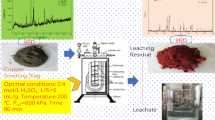Abstract
The changes in the wetting angle between sulfur and the main minerals in high-sulfur residue were investigated, which reflected the degree of difficulty of association between sulfur and the different minerals under various conditions. Sphalerite, pyrite, gypsum, quartz, and muscovite were selected as the research objects. The experimental results indicated that the wetting angle between sulfur and the five minerals decreases gradually with an increase in the temperature and reaches a stable level at approximately 130°C. Increasing the contents of the additives and the oxygen partial pressure can promote the separation of sulfur and the five minerals. Adding sulfuric acid to the system is conducive to the separation of sulfur and muscovite but not to the separation of sulfur and the other four minerals. Finally, according to the experimental data and a similarity theory, criterion equations for the wetting angle between sulfur and the five minerals were deduced.








Similar content being viewed by others
References
W.A. Jankola, Hydrometallurgy 39, 63. (1995).
B.D. Krysa, Hydrometallurgy 39, 71. (1995).
Y. Wang, H. Wang, X. Li, and C. Zheng, Hydrometallurgy 195, 105400. (2020).
S. Rao, D. Wang, Z. Liu, K. Zhang, H. Cao, and J. Tao, Hydrometallurgy 183, 38. (2018).
S. Qin, K. Jiang, H. Wang, B. Zhang, Y. Wang, and X. Zhang, Minerals 10, 224. (2020).
O. Chaalal, C.M.R. Madhuranthakam, B. Moussa, and M.M. Hossain, ACS Omega 5, 8151. (2020).
H.W. Scherer, Eur J Agron 14, 81. (2001).
S. Jafarinejad, Chem Int 2, 242. (2016).
J.E. Halfyard and K. Hawboldt, Hydrometallurgy 109, 80. (2011).
E. Jorjani and A. Ghahreman, Hydrometallurgy 171, 333. (2017).
F. Liu, J. Wang, C. Peng, Z. Liu, B.P. Wilson, and M. Lundström, Hydrometallurgy 185, 38. (2019).
E.B. Khazieva, V.V. Sviridov, S.S. Naboychenko, and V.A. Menshchikov, Solid State Phenom 265, 1104. (2017).
E.B. Kolmachikhina, E.A. Ryzhkova, and D.V. Dmitrieva, Solid State Phenom 299, 1121. (2020).
S.S. Gómez, L. Bonavera, J.C. Landeira, P. Blanco, F. Blanco, M.L. Sánchez, and F.J.D. Cos, J Mater Res Technol 9, 8117. (2020).
H. Shih, C. Yu, M. Wu, C. Liu, C. Tsai, D. Hung, C. Wu, and H. Kuo, Toxicol Ind Health 27, 691. (2011).
P. Peng, H. Xie, and L. Lu, Hydrometallurgy 80, 265. (2005).
Y. Fan, Y. Liu, L. Niu, T. Jing, and T. Zhang, Hydrometallurgy 186, 162. (2019).
H. Li, X. Yao, M. Wang, S. Wu, W. Ma, W. Wei, and L. Li, J Air Waste Manage 64, 95. (2014).
H. Li, X. Wu, M. Wang, J. Wang, S. Wu, X. Yao, and L. Li, Sep Purif Technol 138, 41. (2014).
H.K. Lin, J Miner Mater Char Eng 2, 1. (2003).
S.L. Suárez-Gómez, M.L. Sánchez, F. Blanco, J. Ayala, and F.J.C. Juez, J Hazard Mater 336, 168. (2017).
G. Liu, K. Jiang, B. Zhang, Z. Dong, F. Zhang, F. Wang, T. Jiang, and B. Xu, Minerals 11, 89. (2021).
A. Croll, J. Markert, M. Volz, and A. Ostrogorsky, Cryst Res Technol 52, 1. (2016).
W. Brostow, V. Gonçalez, J.M. Perez, and S.C. Shipley, J Adhes Sci Technol 34, 1163. (2020).
N. Shchedrina, Y. Karlagina, T.E. Itina, A. Ramos, D. Correa, A. Tokmacheva-Kolobova, S. Manokhin, D. Lutoshina, R. Yatsuk, I. Krylach, and G. Odintsova, Opt Quant Electron 52, 1 (2020).
S.F. Umanskayaa, P.A. Danilov, S.I. Kudryashov, and A.A. Ionin, B Lebedev, Phys Inst+ 46, 29 (2019).
Y. Shi, T. Chen, P. Li, X. Zhu, and Y. Yang, Geol J China Univ 21, 7. (2015).
H. Li, and S. Zhang, Chinese J Geophys 48, 1384. (2005).
L. Tian, A. Gong, X. Wu, Z. Xu, T. Zhang, Y. Liu, K. Wei, and Z. Yu, J Cent South Univ 27, 1703. (2020).
L. Tian, A. Gong, X. Wu, Y. Liu, Z. Xu, and T. Zhang, Int J Min Met Mater 27, 910. (2020).
Y. Liu, Y. Li, T. Zhang, and N. Feng, JOM 66, 1202. (2014).
L. Tian, Z. Xu, L. Chen, Y. Liu, and T. Zhang, Hydrometallurgy 180, 158. (2018).
Acknowledgement
The authors thank Beijing General Institute of Mining and Metallurgy for the assistance with the experimental tests.
Funding
Financial support was provided by the National Key R&D Program of China (2018YFC1902005), the National Nature Science Foundation of China (Nos. 51804136, 52064021, 52074136, 51974140, and 52064018), the China Postdoctoral Science Foundation (nos. 2019T120625 and 2019M652276), the Jiangxi Provincial Cultivation Program for Academic and Technical Leaders of Major Subjects (No. 20204BCJL23031), the Jiangxi Province Science Fund for Distinguished Young Scholars (No. 20202ACB213002), the Merit-based postdoctoral research in Jiangxi Province (No. 2019KY09), the Key Projects of Jiangxi Key R&D Plan (No. 20192ACB70017), the cultivation project of the State Key Laboratory of Green Development and High-value Utilization of Ionic Rare Earth Resources in Jiangxi Province (No. 20194AFD44003), the Program of Qingjiang Excellent Young Talents, Jiangxi University of Science and Technology (JXUSTQJBJ2020004), and the Distinguished Professor Program of Jinggang Scholars in institutions of higher learning, Jiangxi Province.
Author information
Authors and Affiliations
Corresponding author
Ethics declarations
Conflict of interest
We declare that we have no financial or personal relationships with other people or organizations that can inappropriately influence our work. There is no professional or other personal interest of any nature or kind in any product, service, and/or company that could be construed as influencing the position presented in, or the review of, the manuscript entitled “Association Law of Sulfur and Different Components in Zinc-Smelting High-Sulfur Residue.”
Additional information
Publisher's Note
Springer Nature remains neutral with regard to jurisdictional claims in published maps and institutional affiliations.
Electronic supplementary material
Below is the link to the electronic supplementary material.
Rights and permissions
About this article
Cite this article
Gong, A., Xu, JC., Wang, RX. et al. Association Law of Sulfur and Different Components in Zinc Smelting High-Sulfur Residue. JOM 74, 2000–2009 (2022). https://doi.org/10.1007/s11837-022-05173-8
Received:
Accepted:
Published:
Issue Date:
DOI: https://doi.org/10.1007/s11837-022-05173-8




